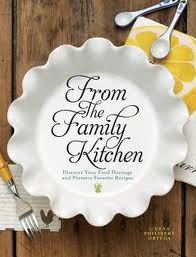Using Food to Bring Family History To Life
Biff Barnes
Genealogist Gena Philibert-Ortega’s wonderful new book From the Family Kitchen promises to help you discover your food heritage and preserve favorite recipes. It will also help you enliven your family history with colorful stories about foods your ancestors ate.

We had an opportunity to ask Gena about her book at the Northern California Family History Expo. Here are the highlights of our conversation:
What made you want to write about food history and to encourage others to explore their food heritage?
I have always been interested in food and what people ate. As I explored the idea of social history and genealogy, food seemed like a great way to tell our ancestors’ stories. The other thing that I have been working on for some time is how we as family historians can better research female ancestors. We are taught to rely heavily on government documents, but they don’t always record women’s lives. Looking at sources unique to women like quilts, journals and food can help tell their story. These items often contain genealogically relevant data like names, places and dates.
You said, “My hope is that this book will encourage you to do two things.” Tell us a little bit about those two goals.
Adding social history to genealogy seems like a natural fit to me. So many of us worry about who will be interested in our research when we are gone. The problem is, for non-genealogists, family history seems like a boring middle-school history class where everything is focused on names and dates. Social history provides a way to bring our ancestors to life. What better way to do that than by incorporating food, something we all can relate to.

While I am passionate about family historians incorporating social history into their family history I also want them to do so with an eye to the future. Someday we will be the ancestors and as such as we should be leaving something to help descendants learn more about our lives. I so often hear people lament that they wish an ancestor had left behind a journal, but how many of us are doing that? (I’m not pointing any fingers here, I’m just as guilty). The everyday, seemingly boring, tasks that make up our days, like procuring and eating food, will be very different for the generations to come. By recording our own family’s food history we leave a history trail for those who are yet to come.
You tell readers, “What we eat is a reflection of so many things – including regionalism, ethnicity and religion…” Can you give us an example of how these things have shaped what winds up on our dinner table?
Probably the best example comes from living in an area where there is a large immigrant population. Eventually the food that immigrants serve at home to their friends and neighbors and in restaurants becomes so common place that the non-immigrant population starts incorporating it into their diets. These foods can also be reinterpreted by the non-immigrant population as well. I write about how Chinese food in America is very different than it is in China. As Chinese restaurants became more popular in American, you start seeing “Chinese” dishes in cookbooks reinterpreted for a non-ethnic audience using ingredients that they would have readily available.
You devote a whole chapter in the book to How to Find Your Ancestors’ Recipes. Can you give us a tip or two for people who want to get started finding their own family recipes?
In family history the first place to consider is home sources. Now we typically take this to mean documents in our own home but a home source could very well mean a document in the home of someone in your nuclear family or in the home of an unknown cousin. This is where social media tools like Facebook, Twitter, and message boards might help you find family who inherited all of the family “stuff,” in this case the family cookbooks and recipe cards.
I would also recommend interviewing family members about their childhood food memories. Even just recalling what dishes they ate can help you go find recipes in period cookbooks and magazines. From the Family Kitchen provides ideas for conducting such interviews.
The book has a wonderful section on Historical Recipes. Do you have a favorite? What makes that recipe special for you?
I love historical recipes. Often my favorite ones are those I would never eat. Part of why I like them so much is they are great reminders of how life has changed. In one of the early nineteenth century community cookbooks I own there is a recipe for “turtle soup.” This recipe is probably more on the gruesome side for modern day audiences since it goes into detail about how you would dispatch and butcher a turtle. What I love about this recipe is it tells a story that is lost to many of us today. While there are people today who have had turtle soup, it’s not as popular as it once was.
You say adding social history – details of the everyday lives of our ancestors – to family history “takes your research to the next level.” What’s an insight about social history you gained in writing this book?
One of the benefits of researching a book is that it teaches you so much. This book really reinforced my notion of the importance of incorporating social history into genealogy. As I was researching the portion of the book on the salt shortage the Confederacy experienced during the Civil War, I learned so much about the Civil War that is not taught in school and that we don’t think of incorporating into our genealogy.
*****
Gena Philibert-Ortega has published three books: Cemeteries of the Eastern Sierra, Putting the Pieces Together, and From The Family Kitchen and hundreds of articles in genealogy newsletters and magazines. She is a frequent speaker in the U.S. and Europe on genealogy, women’s studies, and social history. She edits Crossroads the journal of the Utah Genealogical Association of which she is a board member. Gena is an instructor for the National Institute for Genealogical Studies, VP of the Southern California Chapter of the Association of Professional Genealogists, board member of the Utah Genealogical Association and a Director for the California Genealogical Alliance. She blogs at Gena’s Genealogy and at Food. Family. Ephemera.